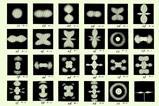Today polyhedra speak to chemists of fullerenes and other cage molecules. But they once had a very different meaning, says Philip Ball
Anyone who has seen Sir Harry Kroto talk about the discovery of C60 may be familiar with the geometric object that sits, grasped by disembodied hands, by the feet of the effigies of Sir Anthony Ashley and his wife on their tomb in the parish church of Wimborne St Giles, southwest of Salisbury, UK (see picture below). As Sir Harry explains, it is a truncated octahedron, with the same framework as the C60 molecule: an assembly of hexagons and pentagons. But what is it doing on the tomb of an Elizabethan nobleman?
In fact, stone polyhedra adorn several early-seventeenth-century church monuments commemorating eminent Englishmen. Historians have shown little inclination to wonder what they mean. But in a paper presented at a mathematical meeting last year,1 mechanical engineer Tibor Tarnai and architectural historian János Krähling of the Budapest University of Technology and Economics in Hungary took a fresh look at the puzzle. They suspect it is no coincidence that all the known examples of these polyhedral sculptures originate within a period of about 30 years, during which England and the rest of Europe saw a resurgence of interest in quasi-mystical geometric symbolism.
Probably the most famous examples are the Ashley memorial and, barely 13 miles away, the tomb of Sir Thomas Gorges, in Salisbury Cathedral. Having held the post of Groom of the Queen’s Privy Chamber for Elizabeth I, as well as other distinguished royal offices, Gorges died in 1610, but the monument wasn’t erected until 1635, after the death of his wife. On top of the tomb are the skeletal frameworks of various polyhedra, including the cuboctahedron, dodecahedron and icosahedron.
Tarnai and Krähling suggest that other such examples may exist. At a geometry festival in Budapest in 1999, the elderly English geometer Harold Coxeter mentioned that as a student in the 1920s he discovered more villages where tombs in churches around Salisbury were decorated with polyhedra.
Polyhedra to the stars
One confused historian has called the Gorges polyhedra ‘astrolabes’2 - instruments for predicting the positions of the stars and planets. Clearly they are not that.
The eminent architectural historian Nikolaus Pevsner erroneously described the Ashley monument object as a ‘sphere of hexagons’.3 One unlikely local tale interprets this object as a stylised ’heraldic cabbage’, based on the mistaken notion that Ashley was the first person to grow cabbages in England.
Probably less mysterious are the five Platonic polyhedra held by allegorical figures on the monument to John Blagrave in the church of St Laurence in Reading, built around the time of his death in 1611; for Blagrave was a mathematician who designed a new astrolabe that he called the Mathematical Jewel. And it may be no surprise that the monument to Sir Thomas Bodley in the chapel of Merton College at Oxford, built in 1615, supports a partially truncated rhombic dodecahedron. The scholarly Bodley was the founder of Oxford’s famous Bodleian Library, and the polyhedron here accompanies the allegorical figure representing geometry along with figures for the other six liberal arts of antiquity.
But neither Gorges nor Ashley had any known mathematical connections, although both were naval men. Their polyhedra are sculpted in a style used in drawings by Leonardo da Vinci for the book De Divina Proportione by his friend, the mathematician Luca Pacioli, which has its 500th anniversary this year. This style was widely imitated, most notably by Johannes Kepler in the early seventeenth century in his representation of the universe as a series of nested polyhedra on which the planets rotate. Kepler worked in the court of the Holy Roman Emperor Rudolf II of Prague, a nexus for the resurgence of interest in Neoplatonism and hermetic philosophy.4 The mathematician and astrologer John Dee, sometime adviser to Elizabeth I, also passed through Rudolf’s orbit. In 1614, these occult enthusiasms were reflected in the spread of the Rosicrucian movement through Europe, which found support in England from the likes of the mystic Robert Fludd.
Platonic geometric symbolism was a prominent strand in this tapestry. Do the monuments of Gorges and Ashley betray a hidden life as Rosicrucians or occultists? It’s quite possible: Pevsner says that Gorges ’was fascinated by the occult meaning of the stars.’5 Given that the discovery of C60 came out of a quest to understand molecules in space that were thought to be formed around carbon-rich stars, perhaps that’s a fitting connection.
References
1 T Tarnai and J Krähling, Proceedings of the IASS-SLTE 2008 Symposium, 27-31 October 2008, Acapulco, Mexico (ed. J G Oliva Salinas), CD-ROM, Universidad Nacional Autonoma de Mexico
2 C J M Fletcher, Wiltshire Archaeol. Nat. Hist. Mag., 1932, 46, 16
3 J Newman and N Pevsner, The buildings of England: Dorset (Penguin, Harmondsworth, 1972).
4 F A Yates, The Rosicrucian Enlightenment (Routledge, London, 1972).
5 N Pevsner and D Simpson, The buildings of England: Wiltshire (Penguin, Harmondsworth, 1963)

















No comments yet